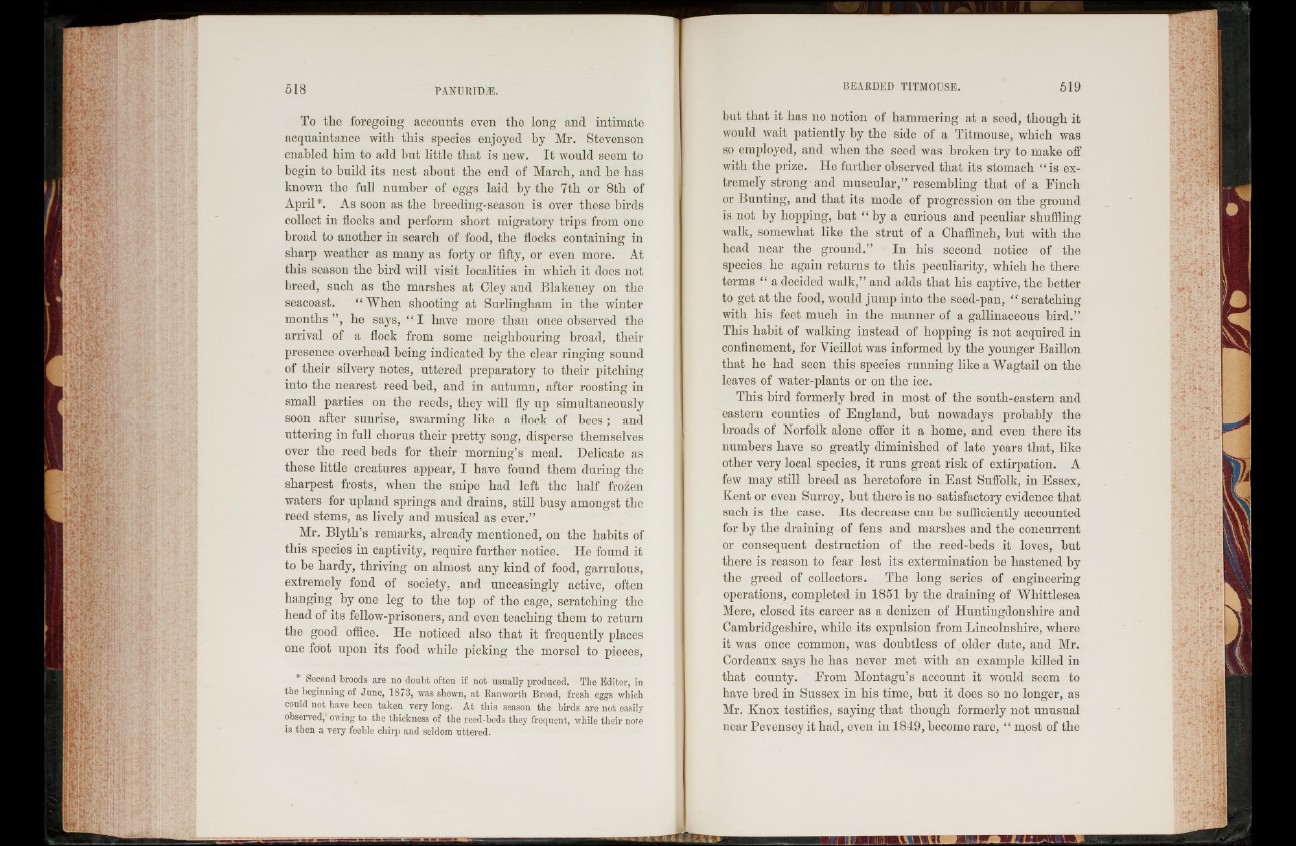
To the foregoing accounts even the long and intimate
acquaintance with this species enjoyed by Mr. Stevenson
enabled him to add but little that is new. I t would seem to
begin to build its nest about the end of March, and he has
known the full number of eggs laid by the 7tli or 8th of
April*. As soon as the breeding-season is over these birds
collect in flocks and perform short migratory trips from one
broad to another in search of food, the flocks containing in
sharp weather as many as forty or fifty, or even more. At
this season the bird will visit localities in which it does not
breed, such as the marshes at Cley and Blakeney on the
seacoast. “ When shooting at Surlingham in the winter
months”, he saj's, “ I have more than once observed the
arrival of a flock from some neighbouring broad, their
presence overhead being indicated by the clear ringing sound
of their silvery notes, uttered preparatory to their pitching
into the nearest reed bed, and in autumn, after roosting in
small parties on the reeds, they will fly up simultaneously
soon after sunrise, swarming like a flock of bees; and
uttering in full chorus their pretty song, disperse themselves
over the reed beds for their morning’s meal. Delicate as
these little creatures appear, I have found them during the
sharpest frosts, when the snipe had left the half frozen
waters for upland springs and drains, still busy amongst the
reed stems, as lively and musical as ever.”
Mr. Blytli’s remarks, already mentioned, on the habits of
this species in captivity, require further notice. He found it
to be hardy, thriving on almost any kind of food, garrulous,
extremely fond of society, and unceasingly active, often
hanging by one leg to the top of the cage, scratching the
head of its fellow-prisoners, and even teaching them to return
the good office. He noticed also that it frequently places
one foot upon its food while picking the morsel to pieces,
Second broods are no doubt often if not usually produced. The Editor, in
the beginning of June, 1873, was shewn, at Ranworth Broad, fresh eggs which
could not have been taken very long. At this season the birds are not easily
observed, owing to the thickness of the l’eed-beds they frequent, while their note
is then a very feeble chirp and seldom uttered.
but that it has no notion of hammering at a seed, though it
would wait patiently by the side of a Titmouse, which was
so employed, and when the seed was broken try to make off
with the prize. He further observed that its stomach “ is extremely
strong and muscular,” resembling that of a Finch
or Bunting, and that its mode of progression on the ground
is not by hopping, but “ by a curious and peculiar shuffling
walk, somewhat like the strut of a Chaffinch, but with the
head near the ground.” In his second notice of the
species, he again returns to this peculiarity, which he there
terms “ a decided walk,” and adds that his captive, the better
to get at the food, would jump into the seed-pan, “ scratching
with his feet much in the manner of a gallinaceous bird.”
This habit of walking instead of hopping is not acquired in
confinement, for Vieillot was informed by the younger Baillon
that he had seen this species running like a Wagtail on the
leaves of water-plants or on the ice.
This bird formerly bred in most of the south-eastern and
eastern counties of England, but nowadays probably the
broads of Norfolk alone offer it a home, and even there its
numbers have so greatly diminished of late years that, like
other very local species, it runs great risk of extirpation. A
few may still breed as heretofore in East Suffolk, in Essex,
Kent or even Surrey, but there is no satisfactory evidence that
such is the case. Its decrease can be sufficiently accounted
for by the draining of fens and marshes and the concurrent
or consequent destruction of the reed-beds it loves, but
there is reason to fear lest its extermination be hastened by
the greed of collectors. The long series of engineering
operations, completed in 1851 by the draining of Wliittlesea
Mere, closed its career as a denizen of Huntingdonshire and
Cambridgeshire, while its expulsion from Lincolnshire, where
it was once common, was doubtless of older date, and Mr.
Cordeaux says he has never met with an example killed in
that county. From Montagu’s account it would seem to
have bred in Sussex in his time, but it does so no longer, as
Mr. Knox testifies, saying that though formerly not unusual
near Pevensey it had, even in 1849, become rare, “ most of the